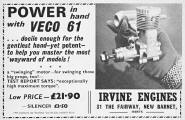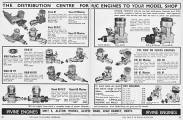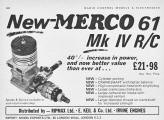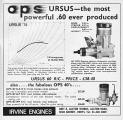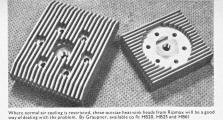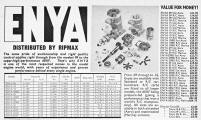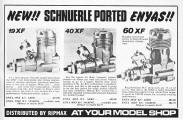RC Helicopter Engines 1970's
By the end of the sixties most manufacturers had started replacing their old models for engines with improved gas flowing plus more efficient carburation resulting in power levels taking quite a 'hike' and increasing by 20-30%. Scavenging was all using the cross-flow principle which required a large flat 'deflector' protruding from the top of the piston in order to deflect the incoming 'fresh' fuel/air charge up the cylinder, over the head and then out of the exhaust port; simple but very inefficient due to the turbulence caused by the dramatic changes in gas direction.
60 size comparisons Part one - Part two - To be in with the 'in crowd' as an engine manufacturer, the 60 size was the most important engine in the range. These two articles cover engines of this size generally available in early 1970.
Enya 60 III TV - Engine test - Jun 1970
Veco 61 - General overview plus OS max 80 aero - May 70
There was a definite trend for engines getting heavier but also more powerful which was to be expected, note the power above quoted at 1.4 BHP (without silencer).
K&B Torpedo 40 - Engine test - Feb 1971
HP 61F - Engine test - May 1971
OS Max-H60 - Engine test - Aug 1971
Note that in later years the designation 'H' would be used by most manufacturers as a generic code for the specific helicopter variant of an engine however, for this model in the OS range it is (as yet) not the case.
Webra 40 - Quick look - Sep 1971
Webra 40 - Engine test - Oct 1971
Veco 61 - Engine test - Feb 1972
Meteor 60 RC - Engine test - Jul 1972
ST G60 RC - Engine test - Mar 1972
OS Series 72 Carb - Review - 1972
Fox Eagle 60 - Engine test - May 1973
HP Range - Engine reviews - Aug 1973
ST G21-46 - Engine test - Aug 1973
Merco Mk4 & Yamada YS60 - Engine review - Sep 1973
OS Max 40 - Engine test - Oct 1973
Merco 61 - Engine test - Dec 1973
The first engine specifically altered for helicopter use was introduced by HB, the 61 Stamo, for dedicated use in the Graupner bell 212.
Webra Speed 61 RC - Engine test - Apr 1974
Enya 60-IIIB - Engine test - Apr 1974
OS Max-25RC - Engine test - Apr 1974
OS Max-H60F GR (Blackhead) - Quick look and preview test.
HB Stamo (red head) - Review with helicopter modifications.
HP 40F - Engine test - Nov 1974
Webra Black-head 61 series 73 - First look review
Another year where the 'flagship' 60 models once again increase in power.
Webra Speed 61 RC - Engine test - Jan 1975
Enya 40 - Engine review plus first look Fox 60 - Feb 1975
OS Max 60F - Engine overview of development - Feb 1975
OPS Ursus 60 - Engine test - Apr 1975
OS Max 60F-SR - Engine review - Jul 1975
Enya 40 - Engine test Aug 1975
OS Max 60F-SR - Engine test - Sep 1975
Webra Speed 61R - Engine test - Nov 1975
OS Max 40F-SR - Engine review - Jan 1976
Kraft 61 RC - Engine test - Feb 1976
Carbs 76 - Review of carburettors fitted to RC engines.
HB 40 & 50 - Engine reviews - may 1976
OS Max 40F-SR - Engine test - May 1976
Irvine 40 - Engine review - Jul 1976
Meteor 40 & 50 - Engine reviews - Sep 1976
Webra Speed 40 - Engine test Oct 1976
HP 61 - Engine test - Jan 1977
ST G60F1 - Engine test - Mar 1977
Enya 60XF - Engine reviews - May 1977
Fox 45BB - Engine test - June 1977
Enya G60XF - Engine reviews - Sep 1977
HB 40 - Engine review both normal and PDP versions - Dec 1977
60 Engines - Part 1 of a survey of 60 size engines available at the time.
60 Engines - Part 2 of the survey of 60 size engines available at the time.
OS 25FSR - Engine review - Jan 1978
OS 45FSR-H - Engine review - Feb 1978
Webra Speed 61F - Engine review - Mar 1978
Enya 40X - Engine test - Jul 1978
Irvine 40 - Engine review - Jul 1978
Irvine Sport 40 - Engine review - Feb 1979
Overview 70's
The Seventies saw engine powers increasing quite dramatically especially with the introduction of Schnuerle porting which resulting in a more efficient scavenging of the burnt gases than the previous method of cross-flow scavenging. In this method of scavenging the piston does not require a deflector plate on the top as the incoming charge is administered from three sides and directed in such a way, because of the angling of the ports that it forms a 'virtual' deflector plate. With a smooth topped piston combustion is also much more efficient and engine powers increases of 50% was the norm for a given engine size.
Generally, engines were provided for 'Aero' use and helicopter designs took into consideration the fact that engines required a positive airflow in order to provide effective cooling; one method being a flywheel mounted centrifugal fan passing air through a shaped duct to the cylinder head. Some engines were developed with a design suitable for helicopter use in particular HB who produced the 61 for the Graupner Bell 212 with a rear crankcase extension to drive the cooling fan followed by the addition of an extended round heat sink head and also the 25 fitted to the Graupner Bell 47G, which incorporated a large oblong heat sink head (which was later to become the norm for helicopter engines). Other manufacturers then followed suit and brought out engines specifically for helicopter use i.e. One aspect noted at the end of the decade was the use of increasing more effective silencer / tuned pipes with development taking into account the porting requirements to work effectively with these fitted.
![]() Webra 40 and 61
Webra 40 and 61 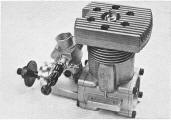 OS 45FSR-H
OS 45FSR-H  HGK 45HC (supplied for Hirobo helicopters)
HGK 45HC (supplied for Hirobo helicopters)

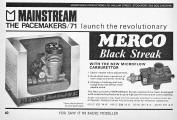
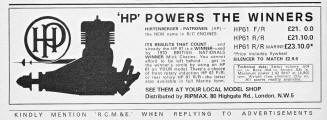

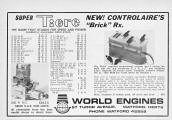

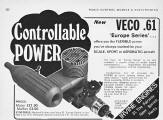
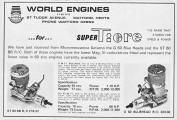

_small.jpg)

